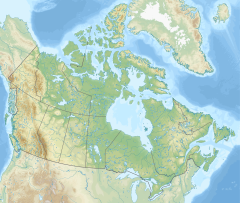| Peel River | |
|---|---|
 Peel River, 1845 | |
| Native name | Teetł'it Gwinjik ( Gwichʼin) |
| Location | |
| Country | Canada |
| Territories | |
| Physical characteristics | |
| Source | Ogilvie Mountains |
| Mouth | Mackenzie River |
• location | Mackenzie Delta |
• coordinates | 67°0′0″N 134°59′3″W / 67.00000°N 134.98417°W [1] |
| Basin size | 73,600 km2 (28,400 sq mi) [2] |
| Discharge | |
| • location | Fort McPherson [3] |
| • average | 691 m3/s (24,400 cu ft/s) [4] |
| • minimum | 46.8 m3/s (1,650 cu ft/s) |
| • maximum | 8,800 m3/s (310,000 cu ft/s) |
The Peel River (Teetł'it Gwinjik [5] in Gwich’in) is a tributary of the Mackenzie River in the Yukon and Northwest Territories in Canada. Its source is in the Ogilvie Mountains in the central Yukon at the confluence of the Ogilvie River and Blackstone River. Its main tributaries are:
- Ogilvie River
- Blackstone River
- Hart River
- Wind River (Yukon)
- Bonnet Plume River
- Snake River (Yukon)
The Peel River joins the Mackenzie in the Mackenzie Delta. However, a distributary of the Peel is the headwater for a channel that later collects distributaries of the Mackenzie. This means that a channel can be followed for a longer distance downriver until it, itself, disseminates into the shared delta. This arguably adds a greater length to the Peel River.
The Dempster Highway crosses it at Fort McPherson, via a ferry during the summer months and an ice bridge during the winter. The Peel River is a wilderness river and Fort McPherson is the only community along its banks. The Yukon part of the Peel Watershed is undergoing land use planning.
Steven Kokelj, a specialist in permafrost, has documented significant changes in the balance of dissolved ions in the river's water as the region's permafrost starts to melt. [6] Ions of elements like calcium and sulphur dissolve easily when the permafrost thaws.
See also
- List of longest rivers of Canada
- List of rivers of the Northwest Territories
- List of rivers of Yukon
References
- ^ "Peel River". Geographical Names Data Base. Natural Resources Canada. Retrieved 2010-11-24.
- ^ "Canada Drainage Basins". The National Atlas of Canada, 5th edition. Natural Resources Canada. 1985. Archived from the original on 4 March 2011. Retrieved 24 November 2010.
- ^ Peel River Above Fort McPherson (10MC002) – Hydrometric data from Environment Canada
- ^ Peel River Above Fort McPherson (10MC002) – Hydrometric data from Environment Canada
- ^ ANLC : Alaska Native Place Names
-
^
Meagan Wohlberg (2013-05-13).
"Permafrost thaw changing chemistry of Peel River: Ancient sediments deposited for the first time affecting streams".
Northern Journal.
Archived from the original on 2014-08-18.
A new study by the NWT's foremost expert on permafrost, Steven Kokelj, who works out of the NWT Geoscience Office, shows a very noticeable increase in the presence of certain ions over the last forty years as the area becomes more and more affected by permafrost thaw.
